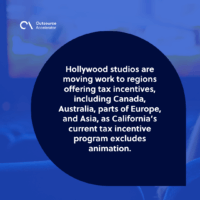Animation outsourcing boom
More animated feature films might be released in theaters and on home screens amid a massive outsourcing trend in Hollywood. Data from Knowledge Source Intelligence shows that the animation outsourcing market is expected to reach $299 billion by 2029, or a 9.35% compound annual growth rate from 2024.
Hollywood studios are moving work to regions offering tax incentives, including Canada, Australia, parts of Europe, and Asia, as California’s current tax incentive program excludes animation. This model mirrors animated TV production pipelines, where creative development occurs domestically while animation is completed abroad.
Producing an animated feature is a long, technical, and costly process. From ideation, storyboarding, and illustration to the animation stage itself, studios spend countless hours and hundreds of millions of dollars on a single project.
Risky business
The animation industry is just a small part of the highly competitive film segment. It’s a high-risk business, as spending millions of dollars won’t necessarily guarantee box-office success. Casting the most popular actor in the world or having the most compelling screenplay isn’t a surefire way to break even.
Flops put immense pressure on studios to recover the hefty losses. That’s why studios are keen on making sequels or remakes. These types of movies pose less financial risk as they have a guaranteed audience.
But critics believe that people will eventually grow tired of these sequels, remakes, and rehashes. They would want something fresh, something they’ve never seen before on the silver screen.
Outsourcing, which significantly reduces costs by 70%, could prompt studios to take on riskier projects more often. These projects, which contain out-of-the-box stories and perspectives, often turn off studio executives because they are not sure if it has a market.
The highest-grossing film
“Avatar”, the 2009 sci-fi epic directed by James Cameron, took more than a decade to make due to its elaborate vision and the uncertainty of studios’ returns on investment. Upon its release, it immediately became a box office hit and is regarded as the highest-grossing film of all time.
Interestingly, “Avatar” outsourced several design aspects to multiple studios to save time. For example, the production of a twin-rotor helicopter was too big to do in-house, so outsourced studios completed several elements of the vehicle. This allowed the production team to stay on schedule and budget.
Cameron’s unique vision and story are the main reasons for its commercial and critical acclaim. However, great business decisions, such as outsourcing, should also be recognized as an intrinsic part of its success.
The question for your business
What parts of your operation can be outsourced?




 Independent
Independent





















